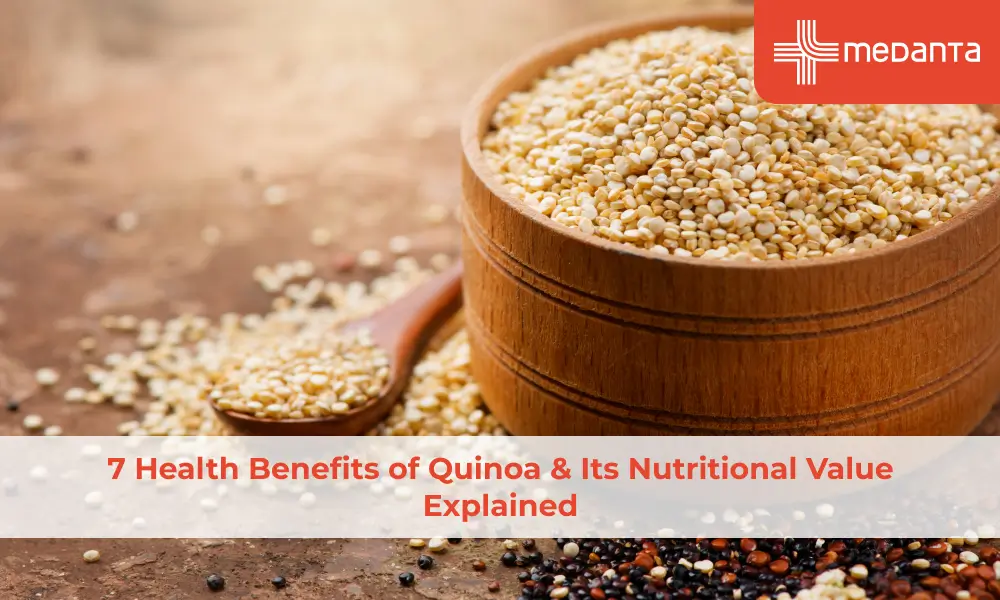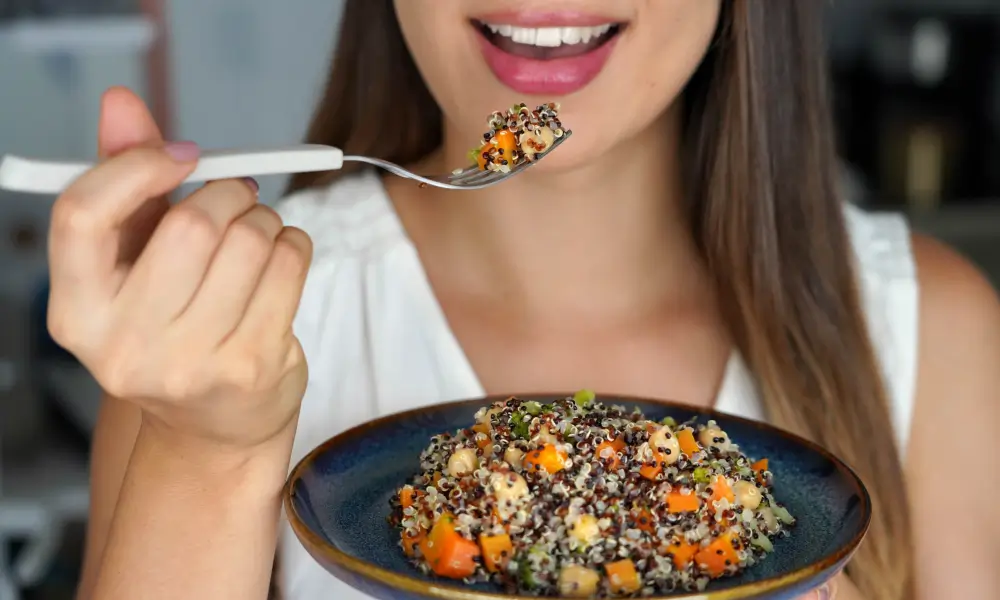7 Health Benefits of Quinoa & Its Nutritional Value Explained

TABLE OF CONTENTS
NASA gives quinoa to astronauts on long space missions showing how nutritious this seed is. This tiny powerhouse stands out among plant foods because it has all nine essential amino acids that humans need to develop and grow.
Quinoa's health benefits match its impressive nutritional profile. The protein content ranges from 13.8% to 16.5%, making it more protein-rich than other grains. This ancient crop provides key nutrients like magnesium, iron, and folate. These exceptional qualities led the Food and Agriculture Organisation of the United Nations (FAO) to name quinoa a "future smart food".
Recent decades have seen quinoa's popularity surge as consumers look for nutritious gluten-free alternatives to standard grains. The seed's versatility in cooking makes it a simple addition to meals that brings health benefits we'll explore in this piece.
What is Quinoa?
Quinoa comes from the Chenopodium quinoa plant a member of the amaranth family. Quinoa is a herbaceous annual plant grown as a crop primarily for its edible seeds. These seeds are high in protein, dietary fibre, B vitamins & dietary minerals, especially potassium and magnesium, in amounts greater than in many grains. Quinoa is a pseudocereal
that is botanically related to spinach and amaranth (Amaranthus spp.). The plant adapts well to high altitudes and produces nutrient-rich seeds. You can find several types in stores these days:
White quinoa has a mild flavour.
Red quinoa gives a nutty taste
Black quinoa provides an earthier profile
Nutritional Value of Quinoa
A cup (185g) of cooked quinoa packs 222 calories with impressive nutrients:
8 grams of protein
5 grams of fibre
3.5 grams of fat
Quinoa's mineral content stands out with:
Manganese (51% DV)
Magnesium (28% DV)
Phosphorus (22% DV)
Iron (15% DV)
The seed also delivers significant B vitamins, particularly folate (19% DV).

How to Include Quinoa in Your Diet
Quinoa fits into your daily meals and many recipes. You can use cooked quinoa
as a foundation for salads, grain bowls, or stir-fries. Add vegetables, herbs, and lean proteins to create a balanced meal. Swap out rice or pasta with quinoa to get a healthier option that has more protein and fiber. It also blends well in soups, stews, and casseroles giving a light, nutty feel.
To start your day, mix quinoa into your morning cereal or blend it into shakes to add more good stuff. Since it doesn't have gluten, quinoa works well for folks who can't eat gluten or have celiac disease.
7 Health Benefits of Quinoa
Quinoa isn't good for you - it has a ton of health perks for your body. Let's take a closer look at how this superfood can make you healthier.
Supports Weight Management: Quinoa's high protein and fibre content make you feel full longer. This helps you control your appetite and eat less. The low glycemic index of quinoa will give a steady energy release without making you feel hungry.
Manage Blood Sugar: Your blood glucose levels stay more stable with quinoa which makes it great for people with diabetes. The fibre and protein slow down how your body digests carbs, which prevents sudden glucose spikes.
Better Gut Health: Quinoa comes packed with dietary fibre that works as a prebiotic to feed good gut bacteria. Research indicates that eating quinoa has a positive impact on bacteria diversity of your gut. It also helps produce short-chain fatty acids and makes your intestinal health better.
Heart Health Benefits: People who eat quinoa regularly tend to have lower blood cholesterol and triglyceride levels. A major research review found that adding quinoa to your diet lowered body weight, waist size, and LDL cholesterol by a lot.
Safe and Gluten-Free Option: You will find quinoa to be a nutritious choice if you have celiac disease or gluten sensitivity. Since it's naturally gluten-free you can enjoy this carb without any bad reactions.
Rich in Essential Nutrients: Your body obtains all nine essential amino acids from quinoa as a complete protein source. It's rich in magnesium, phosphorus, manganese, and iron. You also get B vitamins that boost your metabolism and improve your nervous system's functioning.
Reduces Inflammation: The powerful antioxidants in quinoa like quercetin and kaempferol help curb inflammation throughout your body. These beneficial compounds protect your cells from free radical damage.
Women's Health Benefits: Quinoa is beneficial for women's health due to its high iron content. This helps prevent anaemia, which matters even more during menstruation. The anti-inflammatory properties can also improve your skin's health by reducing irritation and redness.
Conclusion
Quinoa is a remarkable superfood with countless benefits beyond simple nutrition. This tiny seed packs protein, fibre, vitamins and minerals into each serving and remains versatile enough for any meal. People try quinoa as a gluten-free alternative at first, but its nutty flavour and satisfying texture make it enjoyable whatever their dietary restrictions.
Quinoa's health advantages deserve attention. It's filling combination of protein and fibre helps manage weight effectively. This pseudocereal helps keep blood sugar levels stable after meals.
A quick rinse and 15-20 minutes of cooking make quinoa practical on busy weeknights. You can substitute it for rice, add it to salads, or reshape your breakfast routine with this nutritional powerhouse. This superfood deserves its reputation as a "future smart food" that helps anyone eat better while enjoying delicious meals.
FAQs
Is quinoa gluten-free?
Yes, quinoa is naturally gluten-free. Therefore, it serves as an excellent choice for people with celiac disease or gluten sensitivity. Cross-contamination can occur during processing, so certified gluten-free labels should be your guide when purchasing.
Can quinoa help with weight loss?
Yes, quinoa has an influence on weight control due to its high levels of protein and fibre. These nutrients help you feel satisfied for longer periods and reduce unnecessary snacking.
What's the right way to cook quinoa?
Start by washing quinoa in cold water for at least 30 seconds. This removes bitter saponins from quinoa seeds. Then, use a 2:1 ratio of water to quinoa and cook it over low heat for 15 to 20 minutes. You'll know it's done when the quinoa has soaked up all the water. Once you take it off the heat, keep the lid on and let it sit for 5 to 10 minutes.
Is quinoa good for diabetics?
Quinoa's low glycemic index of 53 makes it a great choice for people with diabetes. The fibre and protein content slows down carbohydrate digestion and prevents rapid blood sugar spikes.
Can quinoa be eaten every day?
A Harvard study shows that eating quinoa daily is safe and healthy without side effects.
How does quinoa compare to rice?
The protein and fibre content in quinoa exceeds white rice by a lot. Quinoa packs nearly triple the magnesium and double the iron found in brown rice.
What is the nutritional value of quinoa?
A cup of cooked quinoa (185g) provides:
Calories 222
Protein 8g
Fat 3.5g
Fibre 5g
Carbohydrate 1.6g
Are there different types of quinoa?
Three main varieties are accessible to more people: white quinoa offers the mildest flavour, red brings a nuttier taste, and black provides an earthier, slightly sweeter profile.
Can quinoa be used in salads and other recipes?
Quinoa is a grain you can use in many dishes. It adds texture, nutrients, and a light nutty taste to salads, soups, and casseroles. You can also use it as the main part of grain bowls, to stuff vegetables, or instead of rice.






